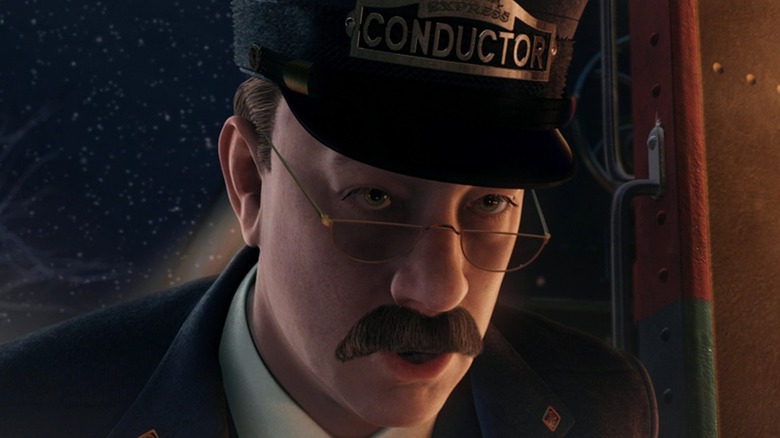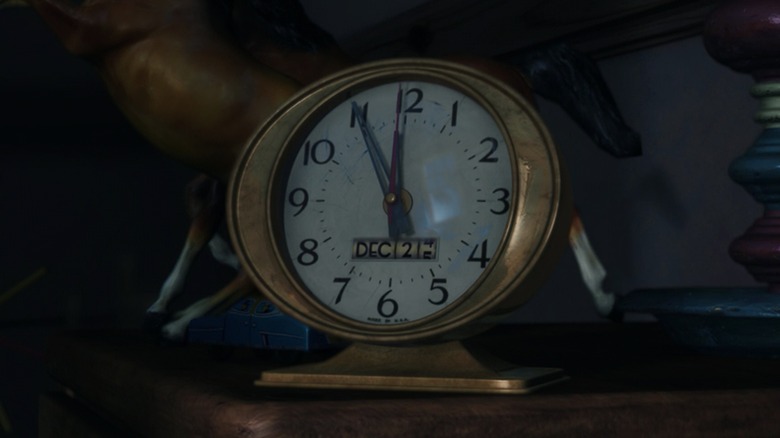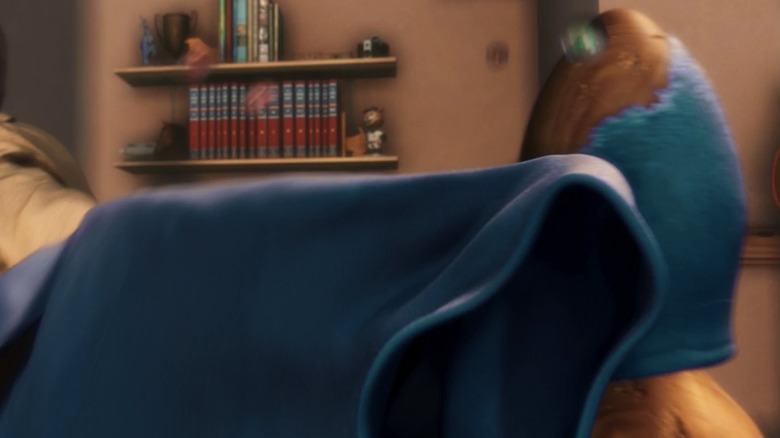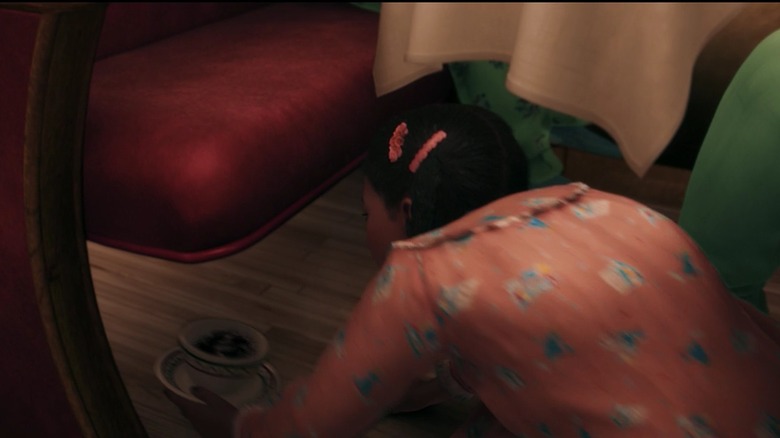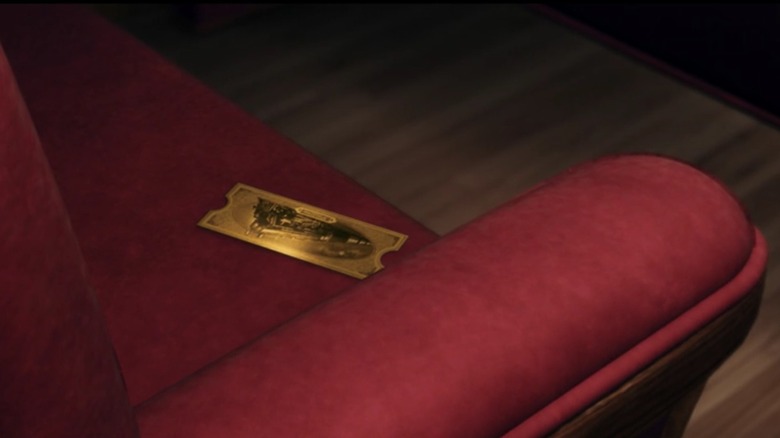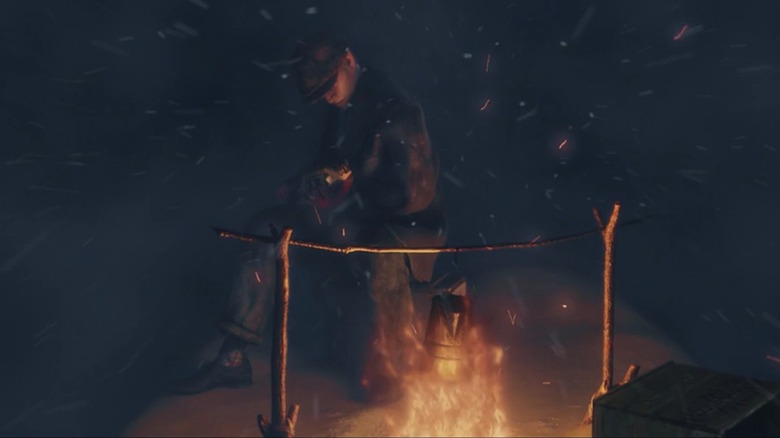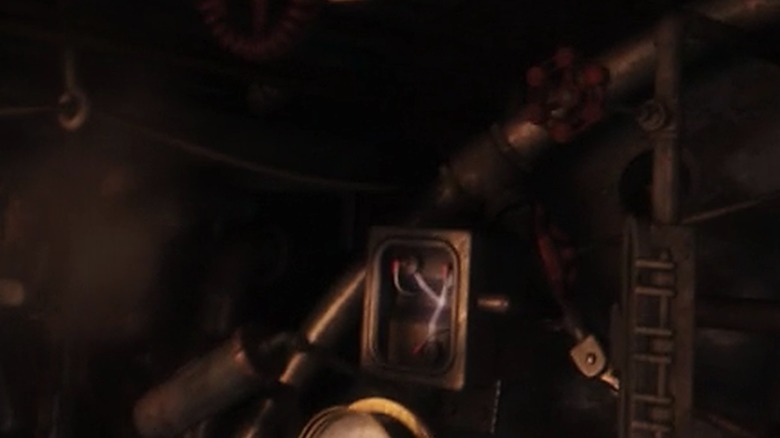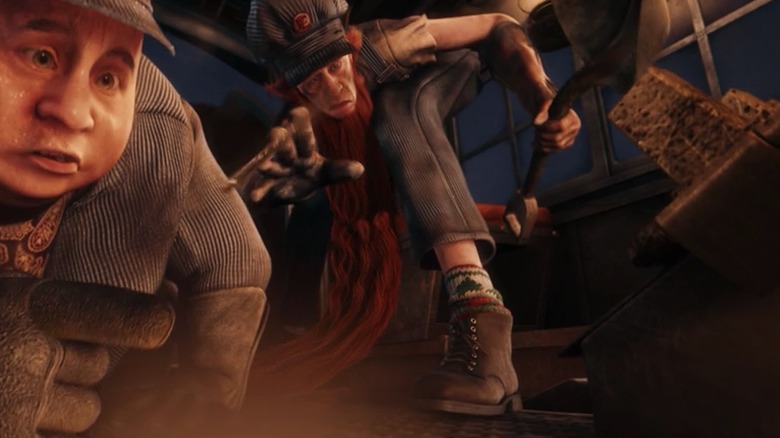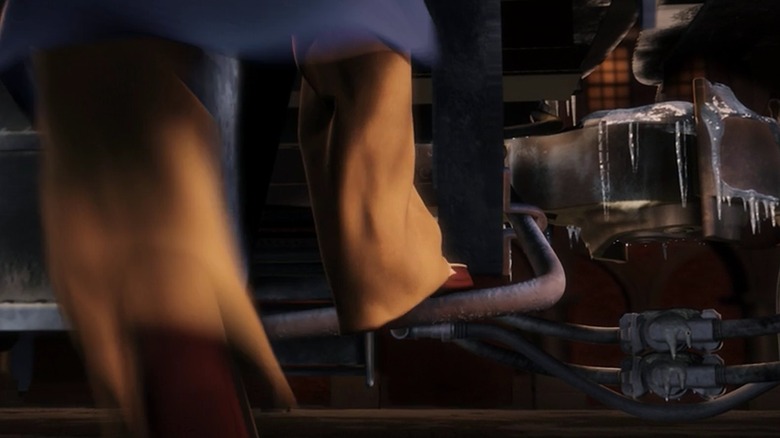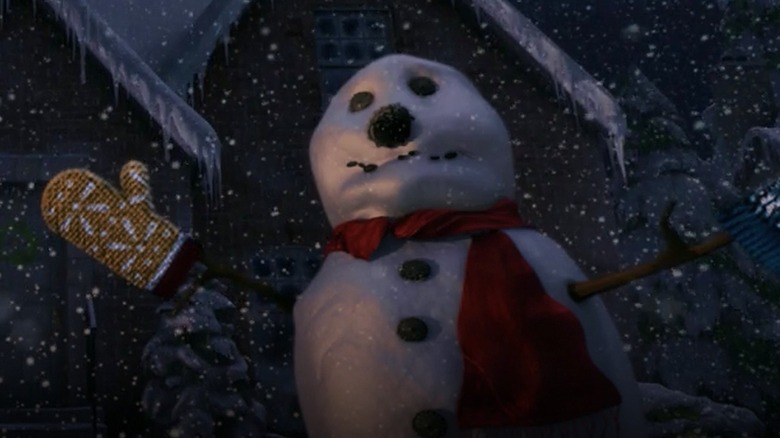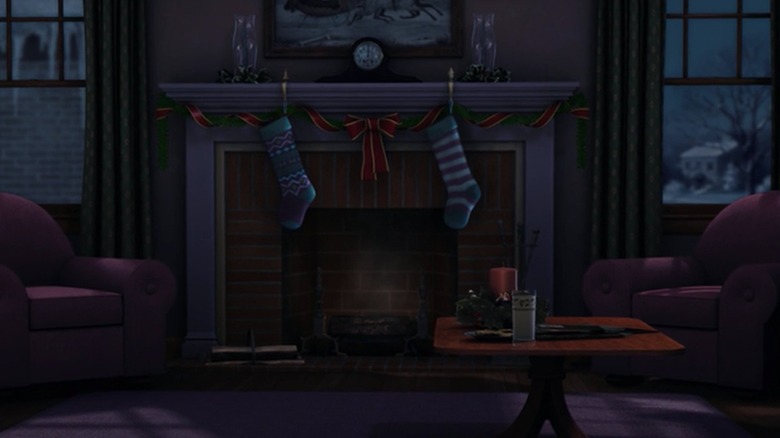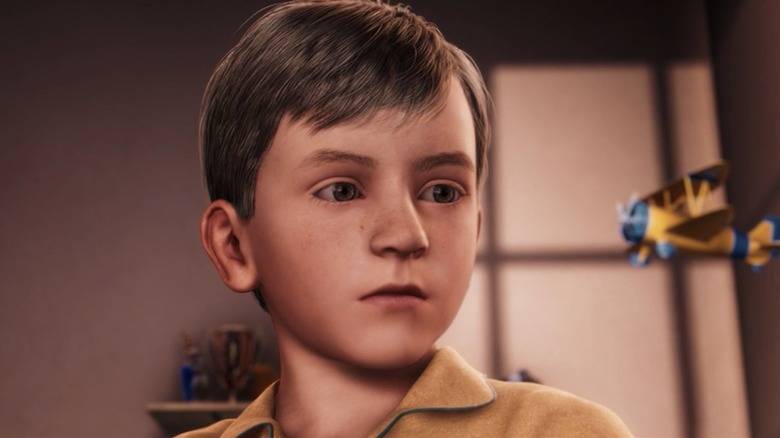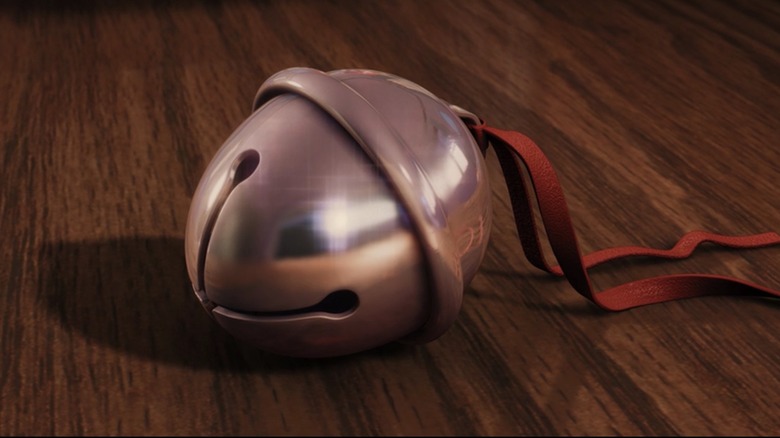Things You May Have Missed In The Polar Express
Robert Zemeckis' 2004 film "The Polar Express" is an adaptation of the children's book of the same name. The story is about a young boy who has reached the age where he begins doubting Santa's existence. This boy has become so skeptical, he has a file of articles about Santas going on strike. He consults an encyclopedia about the North Pole, verifying it is uninhabited. The boy even tells his little sister to put out the milk and cookies for Santa on Christmas eve, because he doesn't want to do it anymore. But when this boy goes to bed, he stays up trying to hear Santa's sleigh bells.
"The Polar Express" was the first capture-animation movie made (and the longest), giving this beloved holiday film its distinctive look. The style of animation gives cartoon characters natural human movements, which is admittedly a little unnerving. Capture-animation fell out of favor shortly after it was first used, but it is a defining characteristic of this film.
This hybrid production style lends a cinematic quality to this animated movie, using different camera angles as we see in live-action films. Because of this, there are numerous little details in this cartoon, such as motifs, Easter eggs, and symbols placed strategically throughout the film. Some of these details are little inside jokes or references to other films and stories. Other times, these details reinforce the themes of the film. Here are some details you may have missed when you watched "The Polar Express."
The bedside clock
Questions about time are often the first children ask when they begin to doubt Santa, such as when the boy overhears his little sister ask their parents how Santa can deliver presents to all the kids in the world in just one night. After hearing this, the boy is restless — like so many children on Christmas Eve — and he can't fall asleep. The childlike excitement for Christmas morning and his skepticism about the veracity of Santa Claus has combined, leaving him listening for the jingle of sleigh bells, not sure what he hopes to hear or not hear.
But like every child who tries to stay up for Santa, the boy drifts into a restless sleep. He awakens suddenly at 11:55, realizing his bedside clock has stopped ticking. Christmas feels like the longest night of the year when you are a little kid, and this film plays with this distorted concept of time. It is when the clock on his bedside table stops ticking that the doubt recedes, and the magic of Christmas begins. Everything in the boy's room vibrates violently, as he hears the horn of a train bellowing. He can see the lights from his window as the train pulls to a stop in front of his house.
The torn pocket
In his excitement, the boy tears the pocket of his robe, grabbing it from where it is hanging at the foot of his bed. As he grabs the robe and dashes out of his bedroom, marbles scatter on the floor. The hole in his robe pocket becomes a part of the story, a detail we are reminded of many times. He realizes his pocket is torn on the train when he looks for his ticket. Later, when he is given the first present of Christmas, he mistakenly puts it into the damaged pocket, losing the gift he received from Santa.
Throughout the movie, multiple characters wonder if this trip to the North Pole on the Polar Express is real or a dream. When we are watching a film where it might be a dream, viewers are in the habit of looking for discrepancies, details, and hints at what is real and what is fantasy. When the boy rises to open presents with his family in the morning, he grabs his robe from the foot of the bed, tearing the pocket, scattering marbles on the floor. Is this a moment of deja vu, or a confirmation his visit to the North Pole was a dream after all?
Hidden cups of hot chocolate
Once the boy is on the train and they have picked up the last passenger, a younger boy, Billy, sits in another train car by himself. The children are treated to hot chocolate by the conductor and a group of singing waiters during a musical number.
A little girl on the train hides two cups of cocoa for the boy in the other compartment. She first hides a cup under the table, and then she hides a second cup under her chair. It is unclear if this is a continuity error in the film-making process or intentional because there is only one extra cup of cocoa for her to give to Billy when she accompanies the conductor to the caboose in the next scene. Both the boy and the girl take a special interest in Billy, trying to make him feel welcome and included, despite Billy isolating himself in the last train car.
The golden ticket
The tickets that the children magically come into possession of once they board the train are revisited repeatedly throughout the film. First, when the boy gives the conductor his ticket to be punched, the conductor leaves two letters on the children's tickets. Later, when they board the train to leave the North Pole, the conductor adds more letters to the tickets, spelling out a lesson for each of the children. The know-it-all is given the message "learn," the girl is given the message "lead," and the boy is told to "believe."
In the middle of the film, the boy goes on an adventure when he loses the girl's ticket and then later tries to take it to her once he has found it again. The ticket creates complications in the film that move the story along, making the boy leave the comfort of the train car for a snowy and dangerous adventure on the top of the train. Other than acting as a catalyst for the adventure section on the train and a way to convey a lesson to the children, we can't help but wonder if the golden pieces of paper are a reference to Willy Wonka's tickets in another beloved children's classic, "Charlie in the Chocolate Factory."
The hobo
The hobo is a mysterious and fascinating character in the film. He helps and terrifies the boy at different points in the story. When the boy first encounters the hobo on the roof of the train, it startles the boy to find him there. They have a conversation about Santa Claus where the hobo mocks Santa, saying he doesn't exist. Interestingly enough, the Santa hat the hobo wears while pretending to be an animatronic Santa has a bell instead of a ball, and the boy hears its chime. When they leave the hobo's campfire to look for the girl, the hobo asks the boy, "Do you believe in ghosts?" When the boy says no, the hobo responds, "interesting," later telling the boy that seeing is believing.
Later, when the boy watches the hobo vanish before his eyes, it is clear the hobo is a ghost. Seeing is believing — a simple statement acknowledging how people determine what to believe. Modernity and adulthood require an acceptance of rational thinking, and most people leave behind the magical thinking of childhood. As a science-based culture, what people think of as real is the tangible things their senses can confirm as truth. If we can see it, touch it, hear it, taste it, or smell it, then it must be real. Witnessing the hobo vanish after distorts the boy's sense of reality. This is when we understand the boy is experiencing a crisis in faith, a theme we revisit later in the film.
The train's power supply
When the boy reaches the engine room of the train after his adventure with the hobo on the top of the train, the boy is relieved to find the girl, but then alarmed when he realizes they have left her alone to drive the train. Through a chaotic series of events, we learn how the train is operated when the boy and girl must stop it because caribou are crossing the tracks up ahead. After this disaster is averted, the engineer and his assistant go back to the locomotive's engine room to get the train moving along.
The assistant scoops coal into the fire to power the train, but another disaster occurs when a pin falls out of the accelerator, causing the train to pick up speed. While the engineer and his assistant scramble to fix the problem, we see a detail that might explain how the train can make the journey to the North Pole and back in one night. Hidden amongst the gauges and levers, we see a flash of a flux capacitor, the technology that makes time travel possible. Well, at least that is what explains time travel in another Zemeckis film. This tiny detail is a fun reference to the 1985 sci-fi gem, "Back To The Future."
The engineer's assistant
"The Polar Express" shows a type of animation that gives the film a cinematic quality, with closeups and interesting camera angles. Simply put, so many little details stand out in this flick.
We wonder if they all hold significance for the story, or if some details are just for fun. During the middle portion of the film, we meet the engineer and his assistant in the engine room of the locomotive. Hilariously, the characters are polar opposites. The engineer is bald, round, and short, whereas the assistant is tall and skinny, with long red hair and a beard to match. During their panicked, slapstick comedy routine trying to retrieve the pin for the accelerator, you may have missed that the engineer's assistant is wearing Christmas socks! Do you think the socks are symbolic and meaningful, or just a fun detail?
The boy's mistakes
One thing you may have missed in "The Polar Express" is how every mistake the boy makes furthers the plot of the film. For example, when the boy realizes the girl has left her ticket on her seat, his mistake leads to his adventure on the roof of the train. This also happens when the boy and girl get out of line at the North Pole to retrieve Billy from the caboose. When the boy follows the girl up the steps to the caboose, he accidentally steps on a lever, disengaging the caboose from the rest of the train. This mistake leads the boy, girl, and Billy on their next adventure, where they explore Santa's toy factory while trying to find their way back to the other children.
This is also when we learn Billy's name and that Santa has a present for him, not to mention it's where the children end up in Santa's toy sack — although it isn't as big as an ocean liner. As the boy's sister suggested, it is magical and huge. The children are then transported back to the tree to see Santa Claus present the first gift of Christmas to one of the children. This is when the clock finally strikes midnight, and it is officially Christmas!
It's almost like the film is telling us something, reminding us that mistakes aren't mistakes at all. They are the lessons we need during our lives, and these experiences lead us to where we were going all along. The conductor also suggests this when he tells the boy, "it doesn't matter where the train is going. What matters is getting on."
The snowman
There is a snowman in the front yard of the boy's house. We see this snowman repeatedly during the film. First, when the boy looks out his bedroom window before trying to go to sleep. Then, once again when the boy runs outside to board the train. Another time is when the boy arrives home from the North Pole, and one final time on Christmas morning.
The snowman is one of those little details one might pay attention to while trying to decide if the boy's trip to the North Pole was a dream or a magical adventure. The snowman has two mittens on his tree branch hands every time but once. When the boy arrives home from the North Pole, the snowman is missing one of his mittens. When we see the snowman again the next morning, we are led to believe maybe the voyage was just a dream after all.
The fireplace
We see the fireplace in the boy's living room twice before he leaves on the train for the North Pole. The stockings are hung on the mantle with care, and we notice a clock on the mantle as well. Before the boy leaves for the North Pole at precisely 11:55, there is a warm fire glowing. When the boy arrives back home at precisely midnight, the clock resumes ticking, but the fire has gone out in the five minutes it took for the boy to travel to the North Pole and back.
Once again, we are thinking logically about how there isn't enough time for any of the boy's adventures to transpire in five minutes, nor for the fire to burn down in those five minutes either. Of course, this is yet another detail for us to file away as evidence that the boy's adventure was a dream. Once again, as viewers, we are thinking with our rational minds, not with the magic of Christmas in our hearts.
The hero boy
One important aspect of this movie that may have slipped your mind while casually viewing is that the boy has no name. In fact, most of the characters don't have names. There are, of course, the conductor and the engineer, who have titles bestowed upon them because of their jobs. There are only three characters who are referred to by name in this film: Santa, Billy, and the boy's sister, Sarah. The credits refer to the main character as the Hero Boy, and his friend is Hero Girl. This is something we often see in fairy tales — nameless characters.
When characters become the King and Queen, or the Prince and Princess (rather than people with names), they become archetypal. Their stories aren't simply personal but universal tales. Characters not having names lends fairy tales and stories like "The Polar Express" a mythic quality, making them both timeless and universal.
The sleigh bell
Listening for Santa's sleigh bells starts the action of "The Polar Express." Throughout the film, we return to this repeatedly. When the boy, girl, and Billy are lost in the North Pole, they follow the sound of sleigh bells through the toy factory, but the boy can't hear them. When they have rejoined the children and elves at the gigantic Christmas tree to see Santa, the boy still cannot hear the bells on Santa's sleigh — or see Santa through the crowd. When a sleigh bell flies off the sleigh and lands at the boy's feet, he still can't hear it. The boy picks it up, repeating the words, "I believe." Only after the boy has verbally renounced his doubt, he finally hears the bell ring. Suddenly, he sees Santa, too.
The boy is gifted the bell by Santa in the North Pole, only to be lost because of the boy's ripped pocket. When it is gone, he has no proof that the trip to the North Pole was real. On Christmas morning, the boy's sister hands him one last box, holding the sleigh bell and a note from Santa. The children can hear the bell, but it is silent for their parents. We learn that the bell went silent for all the boy's friends, even his sister Sarah over the years.
Hearing the bell ring is a metaphor for faith and belief. The film's overall theme is that to experience the magic of Christmas; one must carry belief in your heart. Whether this theme is directed solely at the magic of Christmas or more generally about faith remains unclear, but "The Polar Express" is a story about a young boy who experiences his first crisis in faith: a Hero Boy who learns to believe again, not only in himself but in others.
